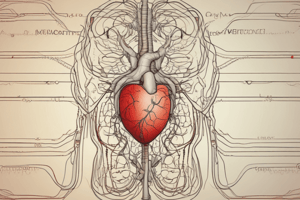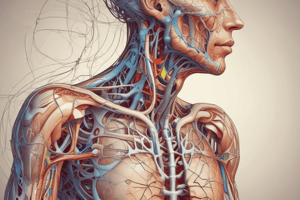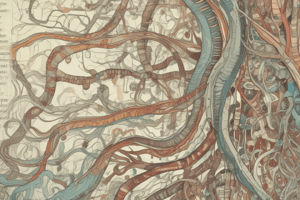Podcast
Questions and Answers
Which part of the heart is primarily innervated by the sympathetic nervous system?
Which part of the heart is primarily innervated by the sympathetic nervous system?
- The entire heart and vascular system (correct)
- Only the AV node
- Only the SA node
- Only the myocardium
What is the neurotransmitter associated with the sympathetic nervous system's action on the heart?
What is the neurotransmitter associated with the sympathetic nervous system's action on the heart?
- Norepinephrine (correct)
- Acetylcholine
- Dopamine
- Epinephrine
Which receptors does acetylcholine act upon in the parasympathetic nervous system?
Which receptors does acetylcholine act upon in the parasympathetic nervous system?
- α-receptors
- M-receptors (correct)
- D-receptors
- β1-receptors
In a resting human, which system exhibits activity in regulating heart rate?
In a resting human, which system exhibits activity in regulating heart rate?
What is the typical resting heart rate range for a healthy adult human?
What is the typical resting heart rate range for a healthy adult human?
What heart rate is achieved when sympathetic activity is increased to 120 beats/min?
What heart rate is achieved when sympathetic activity is increased to 120 beats/min?
Which activity predominates at rest regarding heart rate regulation?
Which activity predominates at rest regarding heart rate regulation?
During inspiration, what is the heart rate observed?
During inspiration, what is the heart rate observed?
What is the primary function of the Bainbridge reflex during inspiration?
What is the primary function of the Bainbridge reflex during inspiration?
What heart rate is typically recorded during expiration?
What heart rate is typically recorded during expiration?
What might the absence of respiratory variations in heart rate indicate?
What might the absence of respiratory variations in heart rate indicate?
How does the heart rate change during respiratory sinus arrhythmia with inspiration?
How does the heart rate change during respiratory sinus arrhythmia with inspiration?
What is the primary consequence of respiratory sinus arrhythmia for gaseous exchange?
What is the primary consequence of respiratory sinus arrhythmia for gaseous exchange?
Flashcards
Sympathetic Influence on Heart Rate
Sympathetic Influence on Heart Rate
The sympathetic nervous system increases heart rate by releasing norepinephrine (NA) which acts on beta-1 receptors.
Parasympathetic Influence on Heart Rate
Parasympathetic Influence on Heart Rate
The parasympathetic nervous system decreases heart rate through acetylcholine (Ach) acting on muscarinic (M) receptors.
Sympathetic Innervation of Heart
Sympathetic Innervation of Heart
The sympathetic nervous system innervates the entire heart including the SA and AV nodes, myocardium, and blood vessels.
Parasympathetic Innervation of Heart
Parasympathetic Innervation of Heart
Signup and view all the flashcards
Normal Resting Heart Rate
Normal Resting Heart Rate
Signup and view all the flashcards
Isolated Heart Rate
Isolated Heart Rate
Signup and view all the flashcards
Sympathetic Activity on Heart Rate
Sympathetic Activity on Heart Rate
Signup and view all the flashcards
Parasympathetic Activity on Heart Rate
Parasympathetic Activity on Heart Rate
Signup and view all the flashcards
Dominant Parasympathetic Influence at Rest
Dominant Parasympathetic Influence at Rest
Signup and view all the flashcards
Respiratory Sinus Arrhythmia (RSA)
Respiratory Sinus Arrhythmia (RSA)
Signup and view all the flashcards
Bainbridge Reflex
Bainbridge Reflex
Signup and view all the flashcards
Absence of RSA
Absence of RSA
Signup and view all the flashcards
Cardiac Dive Response
Cardiac Dive Response
Signup and view all the flashcards
Study Notes
Autonomic Nervous System and the Heart
- The heart receives both sympathetic and parasympathetic innervation.
- The sympathetic nervous system increases heart rate, force of contraction, and the conduction of action potentials.
- The parasympathetic nervous system reduces heart rate and conduction through the AV node.
- At rest, both systems are active, but the parasympathetic system dominates.
- Respiration affects the heart rate.
- An isolated heart beats at 100 beats per minute.
- Adding sympathetic activity increases the rate to 120 beats per minute.
- Adding parasympathetic activity decreases the rate to 70 beats per minute.
- The heart, at rest, receives both sympathetic and parasympathetic activity, but parasympathetic is dominant.
Innervation of Heart and Vessels
- The table shows sympathetic and parasympathetic innervation of different parts of the heart and arteries.
- (Note: the table content of sympathetic/parasynthetic innervation is provided from the image)
Cardiac Dive Response
- Heart rate is recorded using a pressure transducer.
- The subject takes a deep breath and submerges their face in ice-cold water.
- The subject holds the position for as long as possible (usually about 20 seconds).
- Heart rate is recorded throughout the dive.
- The heart rate decreases during the dive, for example: from 88 (before) to 68 (during the dive) beats per minute.
Respiratory Sinus Arrhythmia
- During respiratory sinus arrhythmia, the heart rate increases or decreases during inspiration.
- This is due to changes in vagal tone and sympathetic activity.
- Consequences of RSA affect gaseous exchange in the lungs.
- Changes in heart rate are due to mechanisms like the Bainbridge reflex (aka atrial reflex)
Variations in Heart Rate: Questions
- Approximately what is the normal heart rate at rest in a human?
- At what rate does an isolated human heart beat at normal body temperature(NB. An isolated heart has no functional nerves running to it.)?
- At rest, is there sympathetic nerve activity or parasympathetic nerve activity?
- During the dive, which nervous system is activated?
- Which neurotransmitters and cardiac receptors are involved in the decreased heart rate during the dive response?
- What possible advantages does this parasympathetic reflex provide to diving animals?
Summary of the Autonomic Nervous System
- Heart receives sympathetic and parasympathetic innervation.
- Sympathetic nerves increase heart rate, conduction & contraction.
- Parasympathetic nerves decrease heart rate, conduction & contraction.
- Active at rest but Parasympathetic dominates.
- Respiration affects heart rate.
- Denervated heart (transplant) - any ANS control?
- Denervated heart shows increased sensitivity to adrenaline.
- Denervation increases the number of beta receptors.
Normal Heart Rate
- Normal heart rate at rest is roughly 70-80 beats per minute in humans.
Studying That Suits You
Use AI to generate personalized quizzes and flashcards to suit your learning preferences.




